Notable Buildings
_The Old Malt Shovel
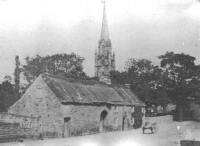
_
The Old Malt Shovel, until the 19th century an old coaching inn with a thatched roof. This photo was taken in the mid–19th century. The church spire looks quite new; it had been built in the 1840’s, when it was possible to replace an old stone chapel dating from the 17th century. The Pudding Tree gives the shade to the right of the picture. That had been the site every 7 years of the distribution of the Burley Pudding, a practice which ceased in 1787. The Malt Shovel was rebuilt in fine style in the late 19th century, hoping to cash in on the tourist trade then building up in the Wharfe valley. Ilkley was the main attraction with its’ spas, and Burley never caught on in the same way. A few years ago the inn closed, giving way to a restaurant. Burley Hall
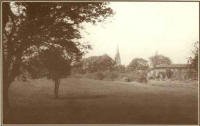
_This was the manor house of Burley and may have been built as early as
the fourteenth century. No doubt rebuilt several times in its history,
the present one dates from the 1820's to replace a house burnt down in
1822. It remained in private possession under a series of families,
until after the Second World War it was sold to the local authorities
for use as a residential home for the elderly. It is now owned by the
private company BUPA as a residential and nursing home.
|
Main Street
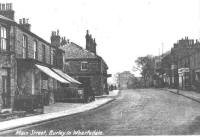
_
This photo of Main Street was taken in the 1920’s when Martin’s Bank was still in business at the top of Peel Place. At this time there were over 60 retail outlets of one kind and another. Most of them were in Main Street and Station Road, but there were one or two others scattered in the village, such as in Crown Street, Grange Road, Back Lane and Bradford Road. This photo is taken looking east with the trees of the Grange in the background. The Grange was at that time the “Town Hall” of Burley, being the offices of the Burley Urban District Council. The Cornmill
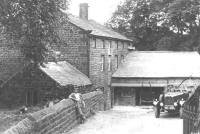
_
The Cornmill – taken in 1920, this photo shows the Clapham brothers, owners of the mill, along with their 1919 Hillman 2 seater. Not much else is known about the origins or the ownership of the mill – can anyone supply any details ? If you can, please e-mail the information to [email protected] Thank you. |
Greenholme Mills and Goit
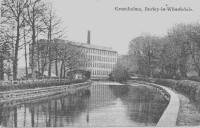
_
This photo was probably taken in the 1920’s. The buildings shown here were started in 1819 and became the core of the major worsted textile works created by Fison and Forster after 1850. The goit supplied water from the weir on the river Wharfe to power the large mill wheel which drove the spinning and weaving machinery.
Greenholme Mills were reputed to be the largest water powered mills in the country in the 19th century. Their main product was blue serge, used for military and police uniforms until the 1960’s.
This photo was probably taken in the 1920’s. The buildings shown here were started in 1819 and became the core of the major worsted textile works created by Fison and Forster after 1850. The goit supplied water from the weir on the river Wharfe to power the large mill wheel which drove the spinning and weaving machinery.
Greenholme Mills were reputed to be the largest water powered mills in the country in the 19th century. Their main product was blue serge, used for military and police uniforms until the 1960’s.